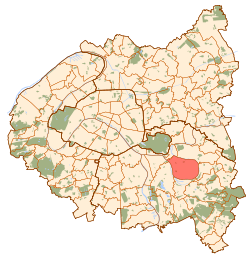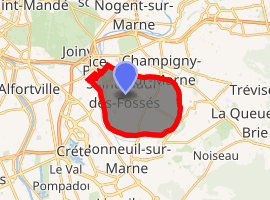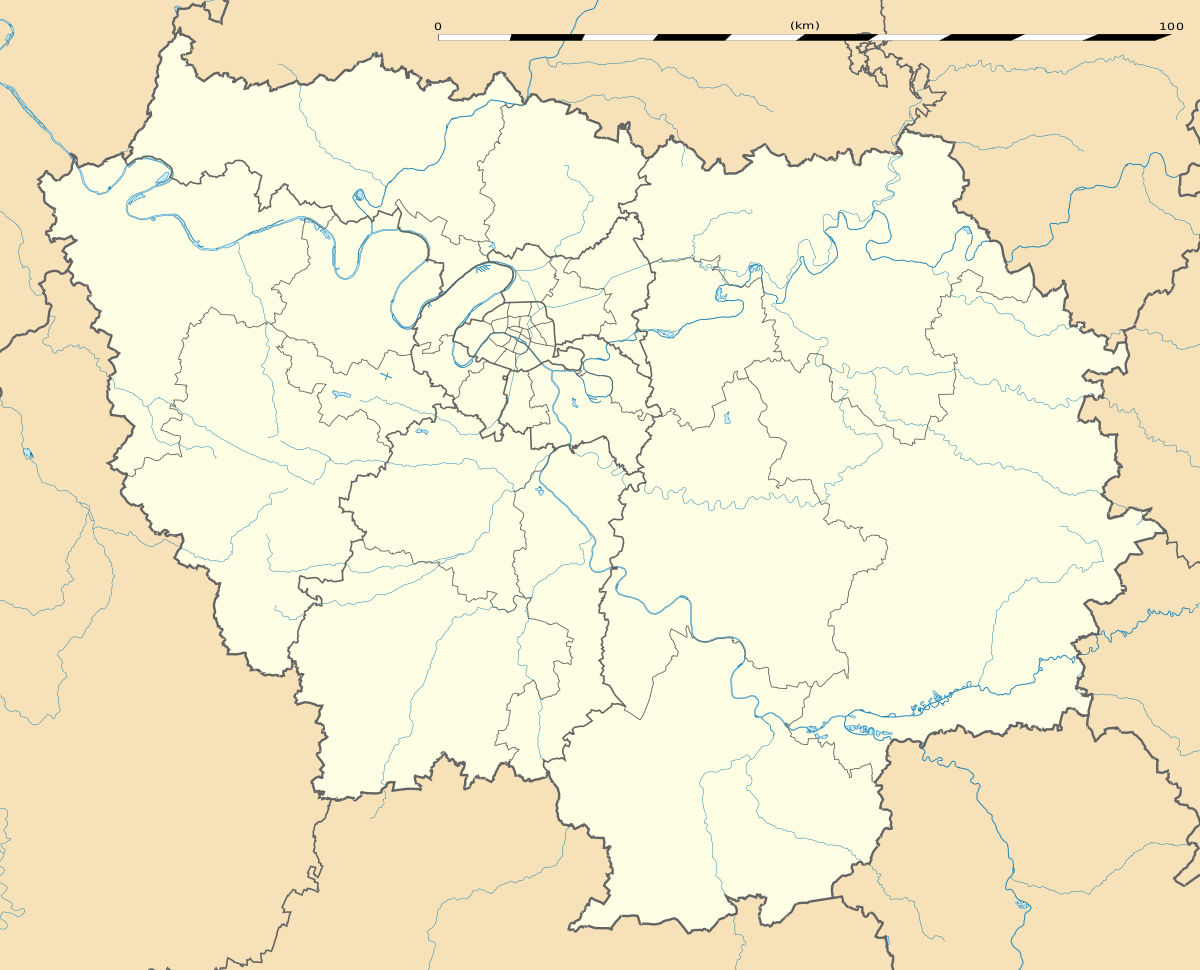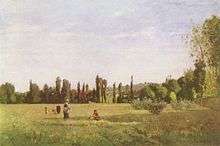Saint-Maur-des-Fossés
Saint-Maur-des-Fossés (French pronunciation: [sɛ̃.moʁ.dɛ.fɔ.se]) is a commune in the southeastern suburbs of Paris, France. It is located 11.7 kilometres (7.3 miles) from the center of Paris.
Saint-Maur-des-Fossés | |
|---|---|
 Town hall | |
.svg.png) Coat of arms | |
 Paris and inner ring départements | |
Location of Saint-Maur-des-Fossés 
| |
 Saint-Maur-des-Fossés Paris and inner ring départements  Saint-Maur-des-Fossés Saint-Maur-des-Fossés (Île-de-France (region)) | |
| Coordinates: 48°47′58″N 2°29′59″E | |
| Country | France |
| Region | Île-de-France |
| Department | Val-de-Marne |
| Arrondissement | Créteil |
| Canton | Saint-Maur-des-Fossés-1 and 2 |
| Intercommunality | Grand Paris |
| Government | |
| • Mayor (2020–2026) | Sylvain Berrios |
| Area 1 | 11.25 km2 (4.34 sq mi) |
| Population (2017-01-01)[1] | 74,859 |
| • Density | 6,700/km2 (17,000/sq mi) |
| Time zone | UTC+01:00 (CET) |
| • Summer (DST) | UTC+02:00 (CEST) |
| INSEE/Postal code | 94068 /94100 (St Maur), 94210 (La Varenne) |
| Elevation | 32–53 m (105–174 ft) |
| 1 French Land Register data, which excludes lakes, ponds, glaciers > 1 km2 (0.386 sq mi or 247 acres) and river estuaries. | |
The abbey
Saint-Maur-des-Fossés owes its name to an abbey founded in 638 by Queen Nanthild, regent for her son Clovis II, at a place called Fossati in Medieval Latin, Les Fossés in modern French, meaning "the moats". This place, located at the narrow entrance of a loop where the Marne River made its way round a rocky outcrop,[2] was probably named after the moats of an ancient Celtic oppidum and later a Roman castrum; the site was known in medieval documents as Castrum Bagaudarum, at a time when the marauding Bagaudae had developed a legendary reputation as defenders of Christians again Roman persecution. Massive foundations, sited so far from a Roman frontier, were attributed by C. Jullian[3] to a temple or a villa instead. In Merovingian times, Gallo-Roman villas in the royal fisc were repeatedly donated as sites for monasteries under royal patronage.
The abbey, dedicated to Saint Peter, Saint Paul and the Virgin Mary, was called Sanctus Petrus Fossatensis in Medieval Latin (Saint Pierre des Fossés in French), meaning "Saint Peter of the Moats". In 868, King Charles the Bald invited the monks of the Abbey of Saint-Maur de Glanfeuil (in Le Thoureil, Maine-et-Loire, western France), who had fled their abbey due to Viking invasion, to relocate to Saint Pierre des Fossés with their precious relics of Saint Maurus.
Later in the Middle Ages, the relics of Saint Maurus became very famous as they were supposed to heal gout and epilepsy, and Saint Pierre des Fossés became one of the most famous pilgrimage centers of medieval France. The rededication to Saint Maurus, in which abbey was renamed Saint-Maur-des-Fossés ("Saint Maurus of the Moats"), was justified by the story that during a drought in 1137, prayers to the Virgin and Saints Peter and Paul having been ineffective, prayer to Saint Maur brought the needed rainfall.[4]
Château de Saint-Maur
The abbey was secularised in 1535, and in 1541, for Cardinal Jean du Bellay, bishop of Paris, the architect Philibert Delorme designed a château on the site, on four ranges of building around a square central court. Catherine de' Medici was a frequent visitor, preferring it to the château de Vincennes; in 1563 she acquired this "château du Bellay", and substantially rebuilt it. On September 23, 1568, her teenage son, King Charles IX, issued the Edict of Saint-Maur, which prohibited all religions but Catholicism. It prompted fierce religious intolerance in Paris and eventually led to the 1572, St. Bartholomew's Day massacre. Building projects at the site were only interrupted by Catherine's death (1589); the château was sold to the Condé family and was eventually completed, and furnished with extensive parterres, at the end of the seventeenth century.

architect: Philibert de l'Orme
The Château de Saint-Maur, still in the possession of the Condé family, was nationalised during the French Revolution, emptied of its contents, and its terrains divided up among real-estate speculators. The structure was demolished for the value of its materials; virtually nothing remains.
The village

The little settlement that grew around the abbey, known as Saint-Maur-des-Fossés, developed a market during the thirteenth century.[2] The present territory also includes a formerly distinct village, La Varenne-Saint-Hilaire, against the perimeter of the nearby game preserve of Saint-Hilaire, part of the abbey's domaines.
In 1791, part of the territory of Saint-Maur-des-Fossés was detached and became the commune of La Branche-du-Pont-de-Saint-Maur, later renamed Joinville-le-Pont.
After the abbey itself was abandoned, its church providing building materials in the town. During the French Revolution, Saint-Maur-des-Fossés was temporarily renamed Vivant-sur-Marne (meaning "Alive upon Marne") in a gesture of rejection of religion.
After the Revolution, the official name of the commune was simply Saint-Maur; it is only in 1897 that "des-Fossés" was re-added to the name, probably to conform to the historical name and also to distinguish Saint-Maur-des-Fossés from other communes of France also called Saint-Maur. In 1924, a few vestiges of the abbey were collected in the newly established Musée du vieux Saint-Maur.
In movies and literature
Saint-Maur-des-Fossés was the filming location for the old-Paris sections of the 1958 Academy award winning film Mon Oncle by Jacques Tati.[5] A statue of Tati in character as Monsieur Hulot along with two other characters from the film is visible in the Commune at Place d'Arme.[6]
Famous residents
Vincenzo Peruggia, an Italian thief who stole the Mona Lisa on 21 August 1911, died in Saint-Maur-des-Fossés.[7]
Philippe Diolé (1908 – 1977), diver, writer and explorer, was born in Saint-Maur-des-Fossés.[8] Germaine Tailleferre (born 'Tallefesse'), (French: [19 April 1892 – 7 November 1983. Composer and the only female member of the group of composers known as Les Six. ref></re Shapiro, Robert (2011). Les Six: the French composers and their mentors, Jean Cocteau and Erik Satie. London: Peter Owen. ISBN 9780720612936.f>
Manu Katché (born 27 October 1958 in Saint-Maur-des-Fossés) is a French drummer and songwriter.
Laurent Pimond (born 6 April 1965 in Saint-Maur-des-Fossés) is a French footballer.[9]
Geography
Saint-Maur-des-Fossés is almost entirely surrounded by a loop of the river Marne.

Demographics
Immigration
| Born in Metropolitan France | Born outside Metropolitan France | |||
|---|---|---|---|---|
| 85.0% | 15.0% | |||
| Born in Overseas France |
Born in foreign countries with French citizenship at birth1 | EU-15 immigrants2 | Non-EU-15 immigrants | |
| 0.7% | 3.6% | 5.2% | 5.5% | |
| 1 This group is made up largely of former French settlers, such as pieds-noirs in Northwest Africa, followed by former colonial citizens who had French citizenship at birth (such as was often the case for the native elite in French colonies), and to a lesser extent foreign-born children of French expatriates. Note that a foreign country is understood as a country not part of France in 1999, so a person born for example in 1950 in Algeria, when Algeria was an integral part of France, is nonetheless listed as a person born in a foreign country in French statistics. 2 An immigrant is a person born in a foreign country not having French citizenship at birth. Note that an immigrant may have acquired French citizenship since moving to France, but is still considered an immigrant in French statistics. On the other hand, persons born in France with foreign citizenship (the children of immigrants) are not listed as immigrants. | ||||
Transport
Saint-Maur-des-Fossés is served by four stations on Paris RER line A: Saint-Maur – Créteil, Le Parc de Saint-Maur, Champigny, and La Varenne – Chennevières.
Saint-Maur-des-Fossés is also served by many buses, like the TVM (Trans-Val-de-Marne), where Saint-Maur-Créteil is one of the bus terminal.
Education
There are 25 public preschools (écoles maternelles) and primary schools in the commune.[10]
Public junior high schools:
Public senior high schools:
- Lycée Marcelin Berthelot[13]
- Lycée d'Arsonval
- Lycée Condorcet
Private schools:
Culture
Saint-Maur-des-Fossés organize a Short Subject Festival. Prizes (2008) : "The Note" by Jon Greenhalgh and Anne-Élisabeth Blateau as best actress.
Twin towns - sister cities
Saint-Maur-des-Fossés is twinned with:[17]



.svg.png)




References
- "Populations légales 2017". INSEE. Retrieved 6 January 2020.
- "Saint-Maur au fil du temps" Archived October 12, 2007, at the Wayback Machine
- C. Jullian discussed the medieval reputation of Bagaudes and the archaeology of the Saint-Maur site in Revue des Études Anciennes 22 (1920:07-17), noted by Sidney J. Deane, "Archaeological Discussions", American Journal of Archaeology 25.2 (April 1921:195.)
- Virginia Wylie Egbert, "St. Nicholas: The Fasting Child" The Art Bulletin 46.1 (March 1964:69-70) p. 69 note 4.
- https://www.imdb.com/title/tt0050706/locations
- https://www.tripadvisor.com/Attraction_Review-g635792-d14063127-Reviews-Mon_Oncle_Hommage_a_Jacques_Tati-Saint_Maur_des_Fosses_Val_de_Marne_Ile_de_Franc.html
- (in Italian) Mio padre, il ladro della Gioconda
- Philippe Diolé, BNF official record
- "Laurent PIMOND". Histoire du #PSG. Retrieved 28 July 2020.
- "Enfance." Saint-Maur-des-Fossés. Retrieved on September 6, 2016.
- Home. Collège Le Parc. Retrieved on September 6, 2016.
- Home. Collège Rabelais. Retrieved on September 6, 2016.
- Home. Lycée Marcelin Berthelot. Retrieved on September 6, 2016.
- Home. Ensemble scolaire Saint-André. Retrieved on September 6, 2016.
- Home. Ecole et collège Jeanne D'Arc. Retrieved on September 6, 2016.
- Home. Lycée Teilhard de Chardin. Retrieved on September 6, 2016.
- "Découvrez Saint-Maur". saint-maur.com (in French). Saint-Maur-des-Fossés. Retrieved 2019-11-18.
External links
| Wikimedia Commons has media related to Saint-Maur-des-Fossés. |
- City Website (in French)
- . Encyclopædia Britannica. 24 (11th ed.). 1911. p. 31.
- Historical and Archaeological Association
- Site des conseillers municipaux de l'opposition (PS-PC)